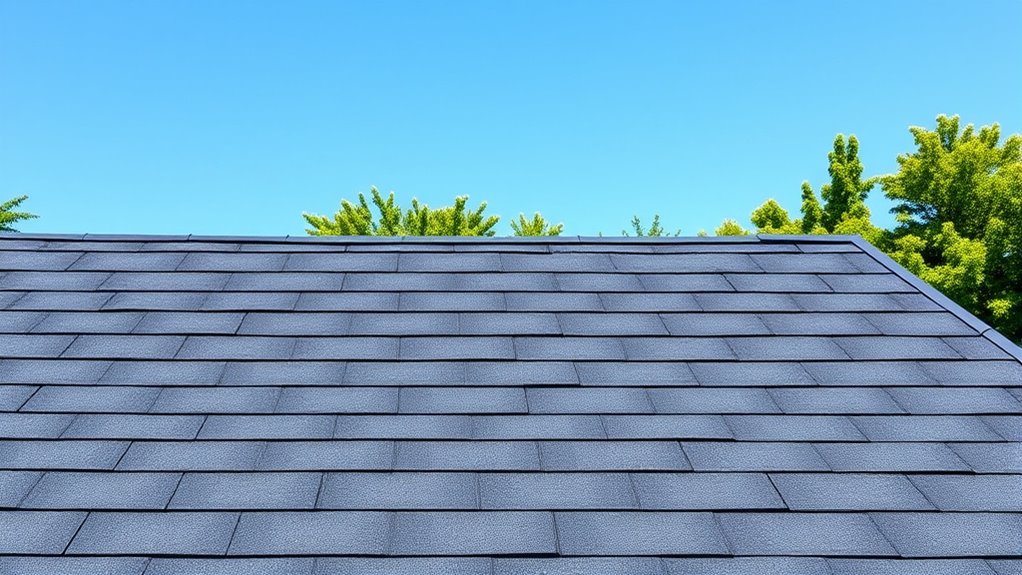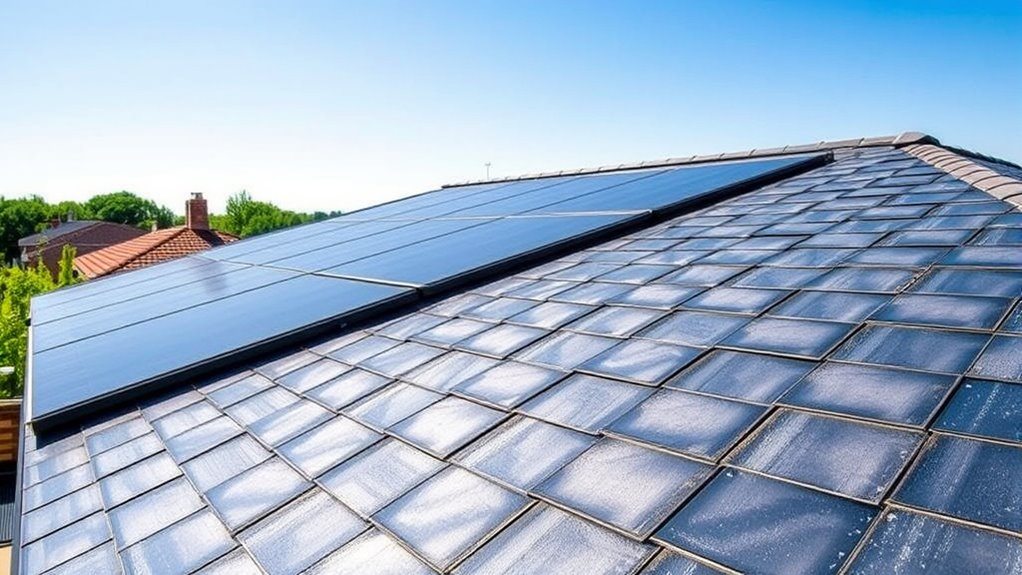Solar shingles are becoming more affordable as technological advances and increased competition drive prices down. While they still cost more upfront than traditional panels, the gap is narrowing, making them a more viable option for many homeowners. Their sleek look and weather-resistant build add extra value. If you want to discover how recent improvements and costs compare today, you’ll find what you need to know below.
Key Takeaways
- Technological advances and increased competition are gradually lowering the costs of solar shingles.
- Initial installation expenses for solar shingles remain higher than traditional panels due to complexity.
- The aesthetic and integrated design of solar shingles can justify higher upfront costs for many homeowners.
- Cost-effectiveness depends on factors like home design, climate, and local labor; they may be cheaper long-term.
- Overall, solar shingles are becoming more affordable, but they are not yet universally cheaper than traditional solar panels.

Have you ever considered how solar technology can blend seamlessly into your home’s design? Solar shingles offer a sleek, integrated alternative to traditional solar panels, allowing you to harness the sun’s power without sacrificing aesthetic appeal. Unlike bulky panels that sit atop your roof, solar shingles are designed to look like ordinary roofing materials, giving your home a modern, streamlined appearance. This aesthetic advantage is a major selling point, especially if you want your solar system to complement your home’s architecture. But beyond looks, you might wonder about their durability and whether they’re truly cost-effective compared to traditional panels.
Solar shingles seamlessly blend into your roof, combining aesthetics with solar power efficiency.
One key concern is solar shingles durability. These shingles are built to withstand harsh weather conditions, such as heavy rain, hail, and strong winds. Manufacturers use tough materials like tempered glass and high-quality polymers to ensure they last for decades. However, because they’re integrated into your roof rather than installed as separate units, any damage or wear over time could be more problematic. For example, if a shingle gets cracked or broken, it might require more complicated repairs than replacing a standard panel. Although solar shingles are designed to be durable, their longevity depends heavily on installation quality and the specific climate where you live.
That brings us to installation challenges. Installing solar shingles isn’t as straightforward as attaching traditional panels. It often requires specialized knowledge, meaning you’ll need a contractor with experience in roofing and solar technology. The process involves removing parts of your existing roof, carefully fitting each shingle, and ensuring proper electrical connections—all while maintaining the roof’s waterproof integrity. This complexity can lead to higher installation costs and longer timelines. Furthermore, improper installation could compromise the shingles’ durability, leading to leaks or early failure. So, while the idea of a seamless, integrated roof is appealing, it’s essential to weigh the potential challenges and costs involved in the installation process.
In terms of costs, solar shingles tend to be more expensive upfront than traditional panels. But with recent technological advances and increased competition, prices are gradually dropping. The question remains whether they’re finally cheaper than traditional panels. Currently, the answer varies depending on your home’s design, local labor costs, and the installation complexity. If you prioritize aesthetics and are willing to invest in proper installation, solar shingles might become a more affordable, attractive option. Overall, they offer a compelling blend of form and function, but understanding their durability and installation challenges helps you make an informed decision about whether they’re the right choice for your home. Additionally, advances in solar technology are contributing to improved durability and cost reduction, making them an increasingly viable option for homeowners.
Frequently Asked Questions
How Long Do Solar Shingles Typically Last?
You might wonder how long solar shingles last. Generally, they last around 20 to 25 years, similar to traditional panels. However, installation challenges and aesthetic considerations can affect their longevity, especially if not installed properly. You should consider that weather, maintenance, and quality influence durability. While their lifespan is comparable, make sure you choose high-quality shingles and a skilled installer to maximize their lifespan and get the best value.
Are Solar Shingles More Durable Than Traditional Panels?
You might think traditional panels are more durable, but solar shingles actually excel in material longevity due to their integrated design and high-quality materials. Plus, they offer seamless aesthetic integration with your roof, reducing wear and tear from weather. While some worry about durability, modern solar shingles are built to last as long as, if not longer than, traditional panels, making them a smart, long-term investment that combines resilience with visual appeal.
Do Solar Shingles Increase Roof Repair Costs?
You might worry that solar shingles will increase roof repair costs, but that’s not always the case. They add minimal roof weight, so they typically don’t cause extra structural issues. Plus, their aesthetic impact is usually positive, blending seamlessly with your roof. However, if repairs are needed, replacing damaged shingles can be more straightforward and affordable compared to traditional panels, potentially saving you money in the long run.
Can Solar Shingles Be Installed on Any Roof Type?
Think of your roof as a blank canvas—you might wonder if solar shingles can be painted on every surface. Roof compatibility depends on your roof’s structure and material, and architectural considerations are key. While they work well on most modern roofs, older or complex designs may pose challenges. It’s best to consult with a professional to assess if your roof can handle solar shingles, ensuring a perfect fit without the fuss.
What Maintenance Is Required for Solar Shingles?
You’ll need to check shingle compatibility to guarantee your solar shingles fit well with your roof. Maintenance is minimal—regular inspections for debris or damage help maintain roof aesthetics and ensure shingles stay effective. Clean off dirt and leaves, and address any cracked or damaged shingles promptly. Keep gutters clear, and schedule professional check-ups periodically. Proper upkeep preserves your roof’s appearance and ensures your solar shingles operate efficiently for years.
Conclusion
As you consider solar shingles, keep in mind that their cost has dropped by over 40% in the past five years, making them increasingly affordable. With energy savings and potential tax incentives, you might find that solar shingles are now a smarter, more cost-effective choice than traditional panels. As technology advances, they could soon become the standard for stylish, sustainable energy solutions—so it’s worth exploring if they’re right for your home.
Amina brings over a decade of journalism experience to her role as Editor-in-Chief. Under her leadership, Exquisite Post has flourished, maintaining the highest standards of integrity and excellence. Amina’s commitment to truth and her visionary approach guide the editorial team in producing impactful news stories that resonate with our audience.










